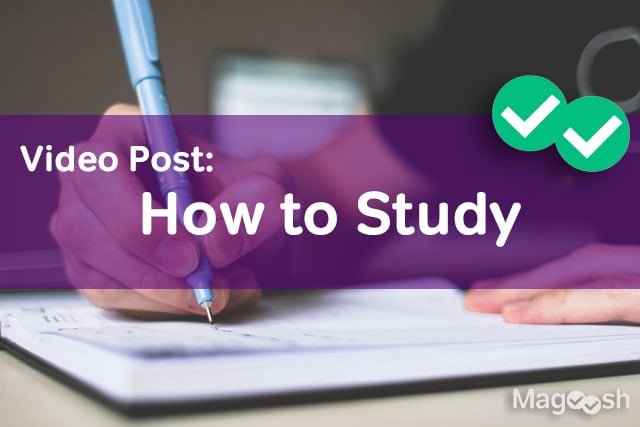Studies on memory have shown that humans forget about half of most newly learned information within twenty minutes – and almost two thirds of that information by the next day!
…That is, if we don’t do any sort of review.
By going back over information, you are moving it from your short-term memory to your long-term memory, where you can count on it to stick around for longer than twenty minutes. So if you’re a student, it’s super important to study!
You probably understand why you should study, but not necessarily how to study.
Have no fear, we’ve got you covered! To get you started down the path to study stardom, we’re proud to present our brand new resource: the “How to Study” video.
Watch the embedded video below, or scroll down for a full video transcript. 🙂
What Will I See in the “How to Study” Video?
In this free video, you’ll receive a brief introduction, followed by eight must-have study hacks:
-
1. Schedule your studying.
2. Don’t cram.
3. Make a cheat sheet.
4. Spend time on the hard material — not just on the stuff that you are enjoying.
5. Figure out the best study conditions and best study location for you (everybody is different!)
6. Find a study buddy.
7. Be present.
8. Use paper.
No one ever really teaches you how to study, and yet it’s a HUGE part of learning and getting good grades. Seriously, studying is a must!
“How to Study” Video Transcript:
Hey, welcome.Today we’re going to be talking about how to study.
Okay, first of all, you clicked on this video, which means that you want to learn how to study better, which is awesome.
A lot of people don’t even make it that far, so go ahead and pat yourself on the back already.
If you would like to see other videos like this, about how to up your study game, your learning game, your life game, like this video and subscribe to this channel, so that you can see a notification when they come out.
Okay, on to the tips.
So my first is to schedule your studying.
First of all, you want to find out when your test is, or when your quiz is, and you want to put it on your calendar.
You just want to get it on there, so it’s not a nebulous date that you’re not really sure when it is, it’s kind of at the end of March, question mark?
You want to know exactly when your test is going to be.
Now that you know exactly when that test is you can work backwards and figure out how much time you have to study.
So if the test is a month from now you have a month to study.
You can then decide exactly how long you want to study.
If it’s that you feel pretty comfortable with material, you know that you need to study a little bit less.
If it’s a test on something that really freaks you out, then you know that you need to study more.
But you got to make an informed decision about how much time you’re gonna spend on it, instead of just seeing how much time you have a week ahead of time, freaking out and cramming, you don’t wanna do that.
As soon as you’ve decided how much time you have to study, now you’re gonna time block it on your calendar.
You’re gonna go through your calendar again or a planner and put in exactly how much you’re going to study.So on Tuesday the fourth, you’re gonna write down, study for one hour for chemistry test.
Then a few days later, study one hour for chemistry test, even putting it exactly in the day when you’re gonna study like from three to 4 PM.
This way you’re not just having it as a to-do list item that may or may not get done, you know the exact day, the exact time that it’s gonna get done.
Then once this time box are on your calendar, you’re gonna wanna keep the appointment with yourself.
Treat it just like you would going and hanging out with a friend.
You’re not gonna just bail on it and not do it and you’re not gonna move it around in your calendar a 100 times to different times that you’ll think you’ll have more time to study.
You’re gonna do it when you said you were gonna do it.
Because you wanna treat yourself as well as you would treat a friend, for a lot of reasons.
But in this case, it’s so that you study well.
Okay, speaking of cramming, tip number 2 is don’t cram.
Please don’t do it.It can be really tempting, but honestly, it never pays off.
You learn a lot less in the short term.
You remember a lot less in the long term.
And there are a lot of scientific studies to back this up at this point.
It’s possible that you could put your body through the nightmare rigmarole of pulling an all nighter, but really, it doesn’t work because of something called the curve of forgetting, which sounds like it should be in Harry Potter.
Basically, it’s a visual representation of how your brain stores memories.
Up at the top of the curve is how much you remember right after you learn something, which is a lot.
But the curve goes steeply downwards if you don’t review that information.
So if you never look over a note that you take in class ever again, it’s pretty probable that a few months out, a few years out, you’re not gonna remember that information.
But if you review that information at regular intervals over time, there’s a much better chance of you retaining it.
Believe me, it may seem like the test you’re about to take is the most important thing and the biggest reason why you need to remember all the US presidents, but you’re gonna want to know that information later.
For example, if you’re becoming an engineer and you’re learning important math concepts, you’re gonna need that math for the rest of your life.
Don’t forget it.
And now for a word from our sponsor.
This video is brought to you today by Magoosh.
Magoosh is online test prep that makes studying for standardized tests accessible, effective, and enjoyable.
That’s awesome.
They teach a lot of different tests including the SAT, ACT, GRE, GMAT, LSAT, MCAT, TOELF, IELTS, Praxis, probably ones that I am even forgetting right now.
So the next time you have standardized test to study for, check out Magoosh.
You can find out more by going to magoosh.com/youtube or checking out the link in the description below.
Magoosh is the shortest distance between you and an acceptance letter.
Tip number 3 is to make a cheat sheet.
Note, I am not saying to cheat.
Do not cheat.
Cheating sucks.
Don’t be that guy.
Okay, now that we have that out of the way, my tip number three is to make a cheat sheet.
Now, what is a cheat sheet?
It’s a small piece of paper, a small list of all the most important information that you’re trying to retain.
So that’s big vocabulary, big formulas, big concepts, the most important figures.
You’re gonna write those down on, say an index card.And you’re going to memorize those.
Now why does this help?
So an index card is pretty small, you have to be pretty economical about what you’re going to put on it.
So this helps you identify the absolute most important information that you need to study.
Another bonus is that if you have kind of a more photographic or visual memory, sometimes seeing it on a card or seeing it on a card in a lot of different colors, if you wanna very swaggy and aesthetic can help you remember the information you are trying to retain.
So if I know that Alexander Hamilton’s name is in the top left corner of my index card in purple gel pen, then I might remember that more easily on the test than if I just saw it in a huge paragraph of text in my textbook.
Tip number 4 is to spend time on the material is hard not just on the stuff that you are enjoying.
So it can be really difficult to spend time on the material that’s hard, because it is hard and scary.
So maybe you are studying you are getting a whole bunch of questions in a row correct.
You want to just keep working on that concept or call it a day because you are doing so well.
But that would mean that you would be ignoring the material that you’re just really stumped by.And that’s not a good plan because if you’re stumped by it while you’re studying, you’re probably going to be stumped by it on the test.
That’s why it’s really important, even though it can be really unpleasant to actually tackle that difficult material that you do not get.
Ask for help from a friend, ask for help from a teacher.
But make sure that you’re not just kind of shoving it off into a corner, and ignoring it, and hoping that it goes away, because it won’t go way.
It will probably come up on the test.
Ultimately, you’re gonna be really glad that you took the time to learn that stuff, so buy yourself a bribery coffee, sit down for an hour and really dive into the material that freaks you out the most.
Tip number 5 is to figure out the best study conditions and best study location for you because everybody is different.
Some people thrive on being at the library surrounded by other people studying.
Some people like to be at home where literally, they are the only person there.Some people like a cafe cuz there’s nice background noise.
You need to take the time to figure out what exactly works for you.
Also think about what level of noise helps you.
Some people like a little bit of cafe clinking behind them.
Some people love’s studying to music, I really like to studying to music that doesn’t have words or that has, words in a language that I don’t understand, and some people really need absolute silence.
So think about what works for you.
In fact take minute to think about times that you’ve been really productive in the last couple weeks, what were the conditions?
Well if you can’t really remember the [LAUGH] last you were really productive, then start keeping score going forward.
As you’re studying in the next few weeks, give yourself a score for one to ten in how productive you’ve been in different environments, and then go back and look at that, and you may have your answer about where you should be studying.Tip number 6 is to find a study buddy.
This has a lot of benefits.
If you two are studying the same thing then you can help each other or teach each other new material because, bonus tip, teaching other people material is a is a great way to learn it better yourself.
And even if you’re not studying the same thing, they are a great tool for accountability.
So if you tell your friend that you two are gonna meet up at a certain cafe at a certain time, then chances are you’re gonna be there and you’re gonna study with them.
In fact, I want you to pause the video right now and text a friend to make a study date.You can do it.
Pause the video.
Don’t just be a passive viewer.
Pause it.
Okay, did you unpause it?
I hope you unpaused it.
If you actually did that I want you to comment below so I can give you a high five through the Internet because that’s awesome.
Tip number 7 is to really be present and actually, actually studying.
This is not the same as saying I’m studying and then kind of messing around on Facebook, coming back to your studies a little bit, day dreaming, spending ten minutes wishing you weren’t studying while you stare blankly ahead at your book.
None of those things are actually focused study.And focused study is what you need to actually learn.
So how do you do that?
One way is to put your devices, your phone in do not disturb mode.
Or you can, gasp, turn your phone off.
Or if you’re working on a paper, you can outside with your computer where there is no WiFi.
Is there even such a place with no WiFi?
There is probably a place with no WiFi.
Another great way to focus is something called the Pomodoro technique.
When you have a big chunk of studying that you wanna do it can feel really daunting to be like I’m going to focus with 100% intensity for a whole hour.
So instead you can try the Pomodoro technique, which involves setting a timer for a chunk of time, say, 25 minutes, studying with a lot of focus for those 25 minutes and then taking a five minute break.
You do this four times.
And then when you’ve done four Pomodoros, which is what the longer study sessions are called, then you get to take a longer break of maybe 20 minutes, half an hour, to really refresh and recharge.
Now, kind of in contradiction to the previous tip, I use a Pomodoro app on my phone, I find it really helpful.
But if you are a phone addict, and you know you can’t have your phone with you, you can also very easily do this with a kitchen timer.
It’s called the Pomodoro technique because it was first done With the kitchen timer shaped like a tomato or a Pomodoro.
Tip number 8, the final tip, I’m just gonna call the power of paper.
So yes, computers are amazing, tablets are amazing, technology is amazing, but for some reason sometimes just plain old paper tends to work better for studying.
I can read something on a screen ten times but if I just write it down my likelihood of retaining that information is a lot higher and there are a lot of scientific studies to back this up.
For example, the one on the screen right here now showed that students in the study required more repetition when they were learning from a computer than when they were learning with just straight up, plain old cheap paper.
So make flash cards.
Use different pens and markers to separate information by color to help you remember it better.
Make yourself little posters of what you’re studying and put them up near where you make your tea or where you brush your teeth.
All of these things are gonna help you learn the information that you are studying better and they can be fun and creative.
You can look up online #studyblur or go on Pinterest for inspiration.
Don’t let anybody tell you that your study time and your note taking has to be totally devoid of creativity and a complete left brain activity.
You get to make studying fun.
And I hope that you make studying fun, if you’re going to be spending a bunch of hours doing it.
[BLANK_AUDIO]
All right, those are all my tips for today.
I hope that that was helpful.
And I want you to take a moment before you close this video to leave a comment about which tip you are gonna commit to, to improve your study game.
Because watching this video does not count as studying.
But you knew that.
Also if I forgot any tips that you want the other viewers of this video to know, put them in the comments because I would love for everyone to learn them.
All right, happy studies.
Want more Study Tips?
Ready for more? Take a look at some of Magoosh’s other free study tips and resources on our High School Blog!
Happy studying! 🙂






Leave a Reply